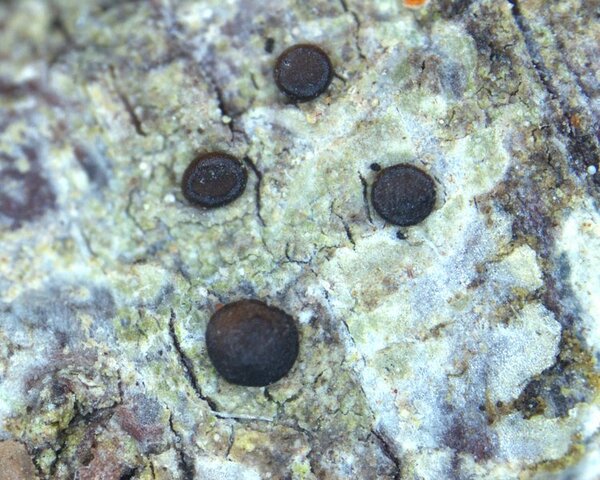Bacidia heterochroa (Müll. Arg.) Zahlbr.
Cat. Lich. Univ., 4: 204, 1926. Basionym: Patellaria heterochroa Müll. Arg. - Flora, 63: 280, 1880.
Synonyms:
Distribution: C - Tosc (Anzi, Lich. Etr. 24).
Description: Thallus crustose, episubstratic, continuous to rimose-areolate, grey to grey-green, sometimes delimited by a dark prothallus. Apothecia lecideine, (0.5-)0.5-0.8(-1.1) mm across, with a convex, usually epruinose, dark purple-brown to black, often mottled disc, and a concolorous or slightly paler, smooth, persistent or rarely excluded proper margin. Proper exciple 45-120 µm wide, without crystals or rarely with radiating clusters of crystals, brown or red-brown in upper and outer parts, pale yeI1ow to colourless within, the pigmented parts K+ purplish; epithecium brown to black-brown, K+ purplish N+ orange-red, located in the cell walls, forming distinct grey-brown caps over apices of paraphyses; hymenium colourless or with brown vertical streaks, 75-115 µm high, the pigment located in the cell walls, forming distinct grey-brown caps over apices of paraphyses; paraphyses 0.8-1.6 µm thick at mid-level, the apical cells not swollen to clavate, (1.2-)2-3(-4) µm wide, with a grey-brown cap; hypothecium colourless or pale yellow. Asci 8-spored, clavate to cylindrical-clavate, the apical dome K/I+ dark blue with a pale, conical-pointed apical cushion (axial mass), the wall I-, but the thin outer gel I+ blue, Bacidia-type. Ascospores (2-)4-12-septate, hyaline, needle-like, straight to slightly curved, (32-)36-67(-73) x (2.5-)3-4(-4.3) µm. Pycnidia partly or entirely immersed, dark in uppermost part. Conidia simple, thread-like, curved, 5-10 x c. 1 µm. Photobiont chlorococcoid. Spot tests: thallus K- or rarely K+ yellowish, C-, KC-, P-. Chemistry: thallus without lichen substances or with traces of atranorin; epithecium, rim of proper exciple, and pycnidial wall with the Laurocerasi-brown pigment; hypothecium and inner part of proper exciple with the Rubella-orange pigment.Note: this epiphytic species was described from the surroundings of Buenos Aires, and is known from several localities in tropical areas (Ekman 1996). According to Ekman (in litt.), material in LD distributed by Anzi in Lich. Rar. Etruriae n 24 under “Bacidia atro-grisea, ad Quercuum juniorum cortices prope Florentiam" belongs to this species, which in Europe was frequently confused with B. laurocerasi.
Growth form: Crustose
Substrata: bark
Photobiont: green algae other than Trentepohlia
Reproductive strategy: mainly sexual
Most common in areas with a humid-warm climate (e.g. most of Tyrrenian Italy)
Commonnes-rarity: (info)
Alpine belt: absent
Subalpine belt: absent
Oromediterranean belt: absent
Montane belt: absent
Submediterranean belt: absent
Padanian area: absent
Humid submediterranean belt: very rare
Humid mediterranean belt: very rare
Dry mediterranean belt: absent

Predictive model
Growth form: Crustose
Substrata: bark
Photobiont: green algae other than Trentepohlia
Reproductive strategy: mainly sexual
Most common in areas with a humid-warm climate (e.g. most of Tyrrenian Italy)
Commonnes-rarity: (info)
Alpine belt: absent
Subalpine belt: absent
Oromediterranean belt: absent
Montane belt: absent
Submediterranean belt: absent
Padanian area: absent
Humid submediterranean belt: very rare
Humid mediterranean belt: very rare
Dry mediterranean belt: absent

Predictive model
 Index Fungorum
Index Fungorum
 GBIF
GBIF





